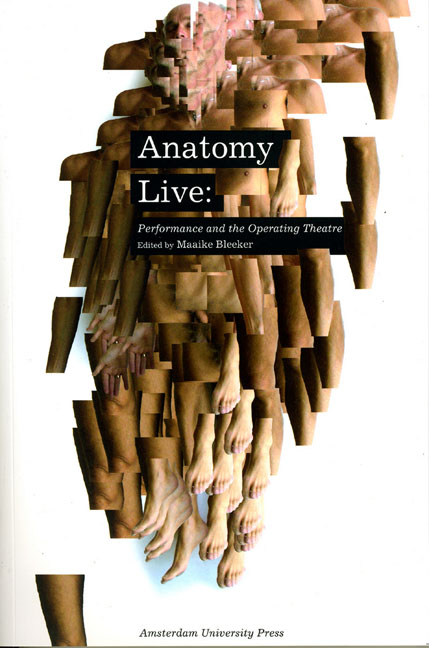Book contents
- Frontmatter
- Contents
- Acknowledgements
- Prologue - Men with Glass Bodies
- Introduction
- Performance Documentation 1: Holoman; Digital Cadaver
- Digital Cadavers and Virtual Dissection
- ‘Who Were You?’: The Visible and the Visceral
- Performance Documentation 2: Excavations: Fresh but Rotten
- The Anatomy Lesson of Professor Moxham
- ‘Be not Faithless But Believing’: Illusion and Doubt in the Anatomy Theatre
- Performance Documentation 3: De Anatomische Les
- Of Dissection and Technologies of Culture in Actor Training Programs – an Example from 1960s West Germany
- Ocular Anatomy, Chiasm, and Theatre Architecture as a Material Phenomenology in Early Modern Europe
- Performance Documentation 4: Camillo – Memo 4.0: The Cabinet of Memories – A Tear Donnor Session
- Martin, Massumi, and the Matrix
- Performance Documentation 5: Sensing Presence no 1: Performing a Hyperlink System
- ‘Where Are You Now?’: Locating the Body in Contemporary Performance
- Performance Documentation 6: Under My Skin
- Anatomies of Live Art
- Performance Documentation 7: Crash
- Restaging the Monstrous
- Delirium of the Flesh: ‘All the Dead Voices’ in the Space of the Now
- Performance Documentation 8: Körper
- Operating Theatres: Body-bits and a Post-apartheid Aesthetics
- Index
Of Dissection and Technologies of Culture in Actor Training Programs – an Example from 1960s West Germany
Published online by Cambridge University Press: 10 February 2021
- Frontmatter
- Contents
- Acknowledgements
- Prologue - Men with Glass Bodies
- Introduction
- Performance Documentation 1: Holoman; Digital Cadaver
- Digital Cadavers and Virtual Dissection
- ‘Who Were You?’: The Visible and the Visceral
- Performance Documentation 2: Excavations: Fresh but Rotten
- The Anatomy Lesson of Professor Moxham
- ‘Be not Faithless But Believing’: Illusion and Doubt in the Anatomy Theatre
- Performance Documentation 3: De Anatomische Les
- Of Dissection and Technologies of Culture in Actor Training Programs – an Example from 1960s West Germany
- Ocular Anatomy, Chiasm, and Theatre Architecture as a Material Phenomenology in Early Modern Europe
- Performance Documentation 4: Camillo – Memo 4.0: The Cabinet of Memories – A Tear Donnor Session
- Martin, Massumi, and the Matrix
- Performance Documentation 5: Sensing Presence no 1: Performing a Hyperlink System
- ‘Where Are You Now?’: Locating the Body in Contemporary Performance
- Performance Documentation 6: Under My Skin
- Anatomies of Live Art
- Performance Documentation 7: Crash
- Restaging the Monstrous
- Delirium of the Flesh: ‘All the Dead Voices’ in the Space of the Now
- Performance Documentation 8: Körper
- Operating Theatres: Body-bits and a Post-apartheid Aesthetics
- Index
Summary
The Actor as Mediator between Inside and Outside: A Historical Trajectory
The practices of representing and constructing certain ways of knowing one's body in acting theories and acting programs are historically contingent as well as participating in historical long-term processes. Since early modern times, these processes have been conditioned by an interlocking of cultural practices, aesthetic forms, technical innovations, and strategies of producing and transmitting knowledge of the body. In his study of the Renaissance culture of dissection, Jonathan Sawday investigates early modern ways of knowing the body at the intersection of medical discourses, scientific procedures, representational practices, cultural conventions and an increasing emphasis on seeing as a mode of knowledge production. Focussing on the practices of dissecting and representing that which hitherto remained unseen in cultural discourse, he argues that ‘the early-modern period sees the emergence of a new image of the human interior, together with a new means of studying that interior, which left its mark on all forms of cultural endeavour in the period’ (Sawday, 1995, p. viii).
Not surprisingly, his study presents a large number of historical images representing diff erent views of the various organic layers inside the human body of flesh as they were known, knowable and representable at a specific historical moment. Not only do these pictures remind us of Roland Barthes 's insight that ‘even and especially for your own body, you are condemned to the repertoire of its images’ (Barthes, 1977, p. 36). Not only do they remind me of the impossibility of looking at my own interiority without technologies of representation such as X ray pictures or screens visualizing ultrasound waves. Not only do these images point at the fact that, within an optical space, knowledge of the interior make-up, as much as the exterior appearance of our bodies, is always already representational. The images in Sawday 's book also mark a desire of stabilizing, conserving and disseminating that which is known or should be known through a set of prin ciples by which the body's inside appears to the onlooker.
- Type
- Chapter
- Information
- Anatomy LivePerformance and the Operating Theatre, pp. 113 - 128Publisher: Amsterdam University PressPrint publication year: 2008



